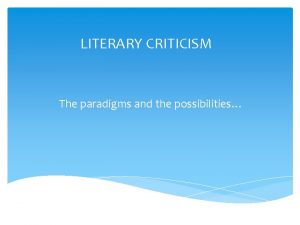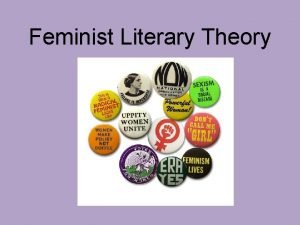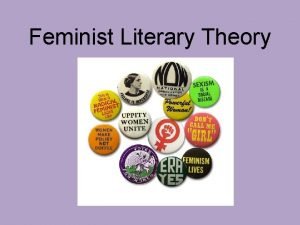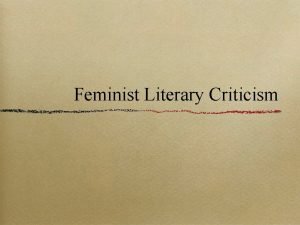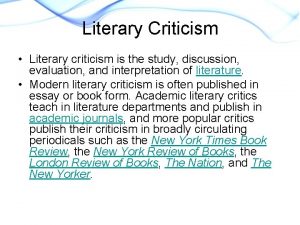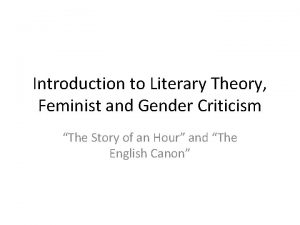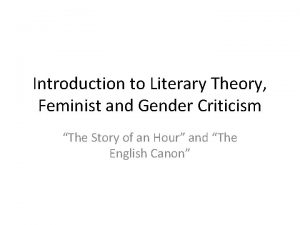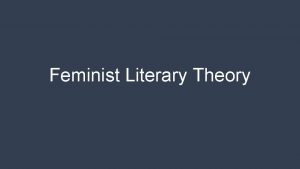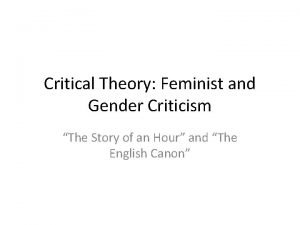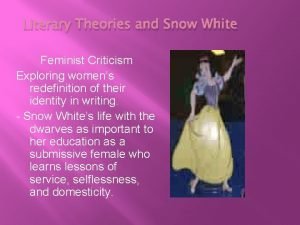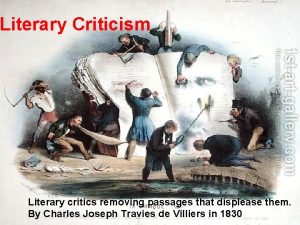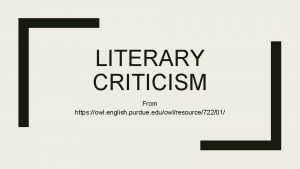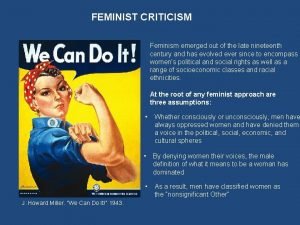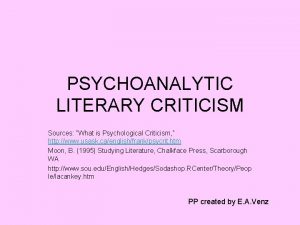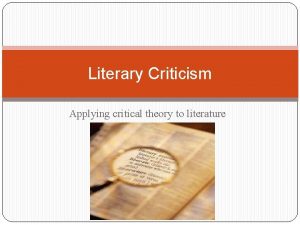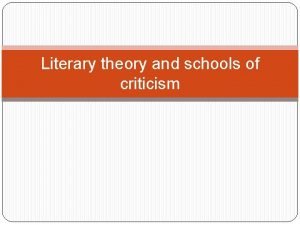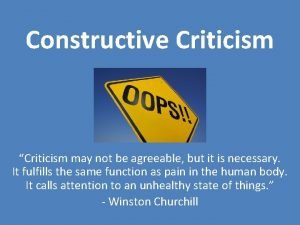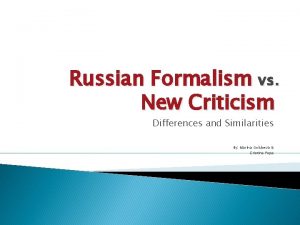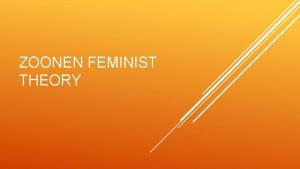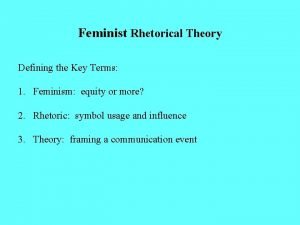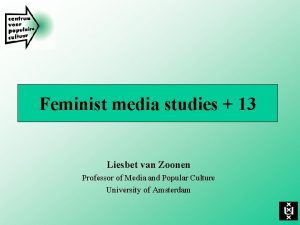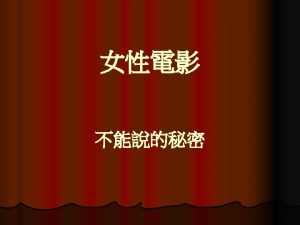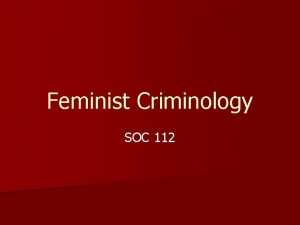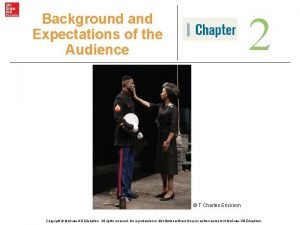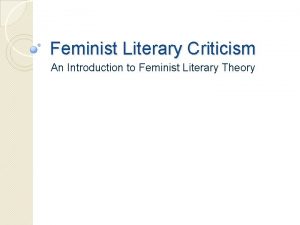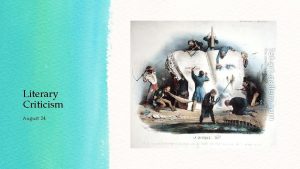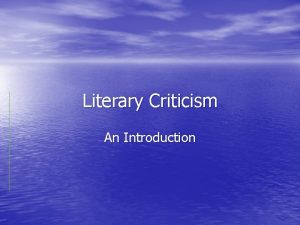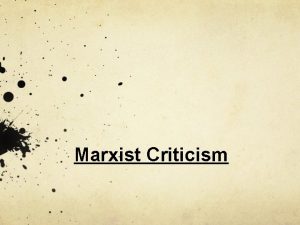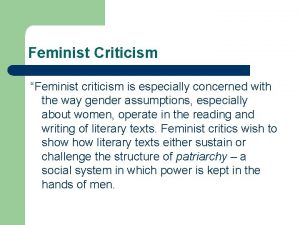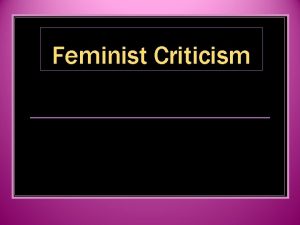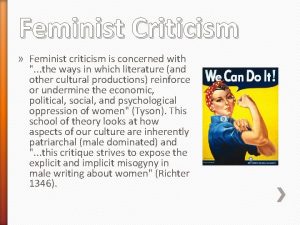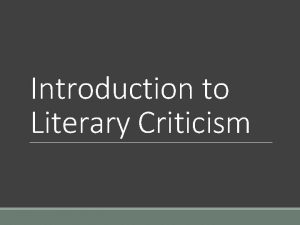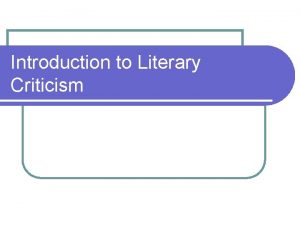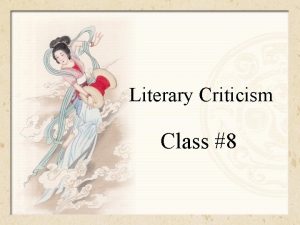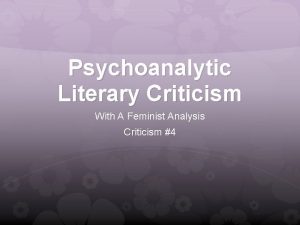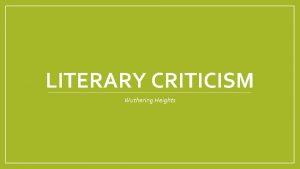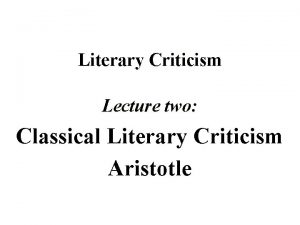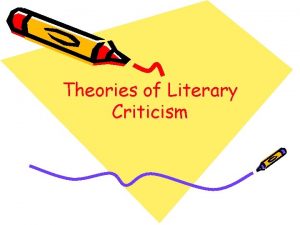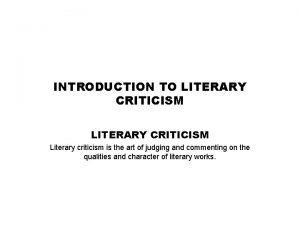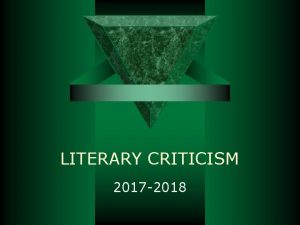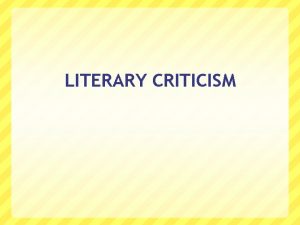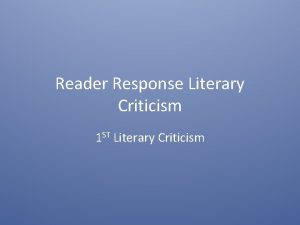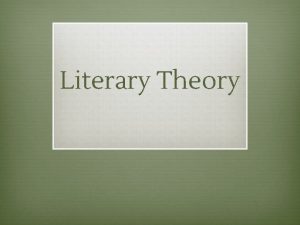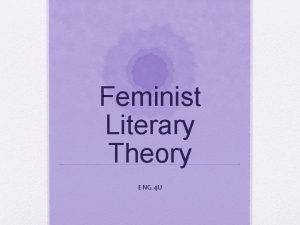ENGLISH LITERARY CRITICISM AND THEORY LECTURE 8 FEMINIST
























- Slides: 24

ENGLISH LITERARY CRITICISM AND THEORY LECTURE 8: FEMINIST CRITICISM & GENDER STUDIES

First-Wave Feminism (1848 -1918) – 19. cent. n n n in the 19 th century women were still dependent on their parents and husbands financially they were not free concerning their property, body and consciousness with limited options in life they mainly study at home (tutors), could not get a university degree (or at some colleges from 1830 s in England; no sciences; first degree after the War) political fight for their rights (e. g. Mary Wollstonecraft for the franchise, +John Stuart Mill) small victories: in 1857 the Matrimonial Course Bill (Divorce Act) was passed

First-wave Feminism (1848 -1918) – 20 th cent. n n n suffragettes: militant and violent protesters with marching and hungerstrikes, fighting for political rights in London (e. g. Emmeline Pankhurst) – in 1918: the right to vote was granted to women suffragists: more pacifists calling for reforms in education, divorce, birth control, and fashion women worked in factories after men were enlisted during First World War image of the ‘New Woman’: independent and threatening (see also in Late Victorian Age - the vamp, and Ibsen’s Nora)






‘Dark Age’ of Feminism (1920 s-30 s) and Woolf in 1918 the first election was a disappointment n women’s awareness should be developed n moving from the political-social to the critical phase / wave n Virginia Woolf as a forerunner, questioning woman’s place in culture and arts n A Room of One’s Own: symbol of artistic, spiritual and financial independence n

Virginia Woolf, ”Professions for Women” (1942) CP 107 -109 she delivered it as a lecture to a working women’s group n her ”profession is literature” (other female writers before her: Fanny Burney, Jane Austen, George Eliot) n writing is ”reputable and harmless”, cheap n writing a review of a man’s book, she encountered a phantom: ”The Angel in the House” n

Virginia Woolf, ”Professions for Women” 2 n n she killed the phantom of male stereotypes in self-defence in order to be able to become a critic and a writer (”what is a woman? ”) other difficulty for a female writer is to find the right words describing womanhood – ”telling the truth about my own experience as a body” and as a passionate being it is a rock for female imagination that it dashes itself against ”rooms of your own” are still bare, they should be decorated and shared (question of language and true relationship)


Second-Wave Feminism (1960 s-1980 s) n n running parallelly with Women’s Liberation Movement (students’ protests for civil rights) in criticism, the forerunner is Simone de Beauvoir, The Second Sex (1949, tr. 1960): ”One is not born but rather becomes a woman. ” concerned with critical theories, terms and the canon; with images of women have in literary works studied categories: ¨ feminist (political) vs. anti-feminist ¨ female (biological) vs. male – SEXES ¨ feminine (cultural and social) vs. masculine – GENDERS

Feminist Criticism – 3 steps 1. in 1960 s the role models, the socially and culturally acceptable versions of the feminine are shown and collected -GENDER STUDIES n 2. in 1970 s the collected images are analysed and criticised (rather attacked) n 3. in 1980 s new critical theories are applied (‘eclectic’) and the new canon is constructed to explore the lost and suppressed records of female experience n

Feminist Criticism (proper) – Elaine Showalter n n n shift from studying women as readers to writers female theory is needed – ”gynocriticism” puts emphasis on pluralisms and differences she differentiates 3 phases of ”gynotexts”: ¨ feminine phase (1840 -1880): women writers imitated dominant male artistic norms ¨ feminist phase (1880 -1920): radical and separatist positions are maintained ¨ female phase (1920 - present): concentrating on female writing and experience

‘Feminist Canon’ in English Literature 1 antecedents: great heroines in male fiction n revolutionary figures in Daniel Defoe’s Moll Flanders and Roxana (1720 s) n melodramatic heroines of stereotypes in Samuel Richardson’s Pamela and Clarissa (1740 s) n though first person narratives, male voice of female characters n

‘Feminist Canon’ in English Literature 2 first great female novelists in the Romantic and Victorian times n Jane Austen’s irony and conventional happy ending (marriage) in her ”muted discourse” n the rebellious ”subversive discourse” of the Brontës (questioning the happy ending and openly writing about passion) n ”the dominant discourse” of Woolf in her novels (Mrs Dalloway, To the Lighthouse, Orlando) n

Feminist Criticism - trends n n n Anglo-American critics are radical in their concepts, redefining feminism, e. g. Elaine Showalter, Sandra M. Gilbert and Susan Gubar (The Madwoman in the Attic, 1979) British critics are concerned about social and cultural implications, e. g. the Marxists Toril Moi and Cora Kaplan French feminists are overtly theoretical with interest in language and psychology, e. g. Julia Kristeva, Hélène Cixous (The Laugh of the Medusa)

Sandra M. Gilbert and Susan Gubar, The Madwoman in the Attic (1979) n n reading of Emily Brontë’s Wuthering Heights as a female version of educational novel, as the construction of gender identity Catherine Earnshaw is taken out from her natural surrounding (WH) and she is taught how to become a lady, a woman, at the Lintons’ place – she is to accept gender roles! stages in her womanhood: imprisonment, alteration, marriage, sickness, self-starvation, madness, death her childhood mate, Heathcliff, returns and accelerates her mental decline, hysteria (cf. Freudian ”return of the repressed”)

‘Feminine or Female Language’? - language is male-centered, man made (not genderfree) – it is gendered - Hèléne Cixous on feminine writing (écriture féminine): loosened grammatical structures, free play of meanings, going beyond logic, rule-transcending - Julia Kristeva (after Lacan’s Symbolic vs. Imaginary) symbolic aspect (prose) vs. semiotic aspect (poetry) n n n father, order, authority control and repression the self is fixed and unified male ”network of differences” phallus as the arch-signifier n n mother, chaos, freedom dreams, linguistic unconsciousness floating signifiers random connections, slippage, improvisation ”visionary semiotic female”

Third-Wave Feminism from the 1990 s n returning to the radicalism of the first wave n calling for actions against violance, child abuse and rape n for motherhood support (welfare, child care), criticising maternity leave policies n organising protests, commemorating days, awareness and alliance days (e. g. V-Day – Eve Ensler’s The Vagina Monologues (1996) n

Gender Studies vs. Lesbian / Gay Studies n n n in the 1990 s Gender Studies of ”academic feminism” got criticised as it became institutionalised (‘white, middle-class, heterosexual, urban women’) ‘classic’ feminism marginalised and ignored the differences of race, class and sexual orientation Lesbian Studies concerned about homophobia and sexuality ‘radicalesbians’ believe in the existance of ”lesbian continuum” in human history (sisterhood of women helping each other, networks, unifying force) Queer Studies (abusive term): lesbianism in dialogue with gay men – sexuality is more fundamental in personal identity

Lesbian Criticism n analyses texts are written by or about lesbians or gays, with homosexual episodes n to establish a canon of ‘classic’ lesbian / gay writers (e. g. Oscar Wilde, K. Mansfield) n attacks binary oppositions, e. g. male vs. female, heterosexual vs. homosexual n Judith Butler on the categories of gay vs. straight mutually defining each other n Eve Sedgwick on concealment vs. openness in the ‘coming out’ of homosexuals

Lesbian Criticism – Monique Wittig, ”One Is Not Born a Woman” (1981) CP 110 -113 n n n n fundamental text in Lesbian / Gay Studies and Queer Studies ”woman is a myth” – similarly to the genders, it is a construct, being made up by men childbearing is ”the female creative act” in Marxism, ”women” and ”men” are political and economic categories (classes) thus, ”a lesbian has to be something else, a notwoman, a not-man” – like ”escapees”, or runaways lesbians are closer to the original spirit of feminism, still fighting for women’s rights new definitions are needed, going beyond categories of sexes and expressing differences
 Sociological criticism
Sociological criticism Feminist literary approach
Feminist literary approach Feminist literary criticism
Feminist literary criticism Feminist literary criticism ppt
Feminist literary criticism ppt Moralist approach examples
Moralist approach examples Feminist criticism definition
Feminist criticism definition Gender criticism definition
Gender criticism definition Feminist criticism questions
Feminist criticism questions Feminist criticism in the story of an hour
Feminist criticism in the story of an hour Snow white theory
Snow white theory Feminist criticism questions to ask
Feminist criticism questions to ask Ecocriticism in literature
Ecocriticism in literature What is feminist criticism
What is feminist criticism Psychoanalytic criticism definition
Psychoanalytic criticism definition Queer theory in literary criticism ppt
Queer theory in literary criticism ppt Structuralism literary theory
Structuralism literary theory Constructive vs destructive criticism
Constructive vs destructive criticism New criticism
New criticism Van zoonens feminist theory
Van zoonens feminist theory Feminist rhetorical theories
Feminist rhetorical theories Liesbet van zoonen feminist theory
Liesbet van zoonen feminist theory Anneke smelik feminist film theory
Anneke smelik feminist film theory Feminist theory criminology
Feminist theory criminology Biblical criticism is not a form of biographical criticism
Biblical criticism is not a form of biographical criticism Descriptive criticism vs prescriptive criticism
Descriptive criticism vs prescriptive criticism
